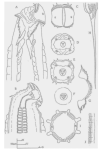 |
Female:
- Body subcylindrical with a conoid to subulate tail.
- Cephalic extremity with a lateral pair of convex
pseudolabial plates which overhang the head tissue and are
attached to the body
- The body cuticle beneath the dorsal and ventral edges of
each pseudolabium is extended to form four slightly concave
flanges
- Four cephalic papillae below the pseudolabia.
- Cuticular adornment of the cervical region of
transverse'rows of minute spinelets, continuous or discontinuous
spined collars, spined combs of various size located anterior to
the collar, lateral cuticular lappets,
- Lateral alae may be well developed or, more commonly,
completely absent.
- Esophagus a long muscular procorpus, short isthmus and a
valvate basal bulb.
- Buccal cavity with a globular anterior part withe dorsal and
two ventro-lateral bosses fringed with fine processes and a
tubular, ribbed, posterior part.
- Vulva is well posterior and the genital tracts prodidelphic.
- Tail long, subulate, attenuating to a fine point.
Male:
- Male lacks the complex cuticular structure of the female anterior
end, the head region being low and rounded with four cephalic papillae
and a ring of six inner papillae around the oral aperture. The buccal
cavity is simple and contains three processes, one dorsal and two
subventral, which may have fine cuticular lamellae. The oesophagus is
similar to that of the female. The spicules are fused for nearly all of
their length, but are separate proximally. Alarge, trough-like
gubernaculum is present. A large round to oval midventral sucker
anterior to the cloaca
- Typically 15 copulatory papillae, 7 paired and s ingle mventral
precloacal
- Tail is long, subulate and then attenuating to a fine point.
Ref Hunt, 1994
|